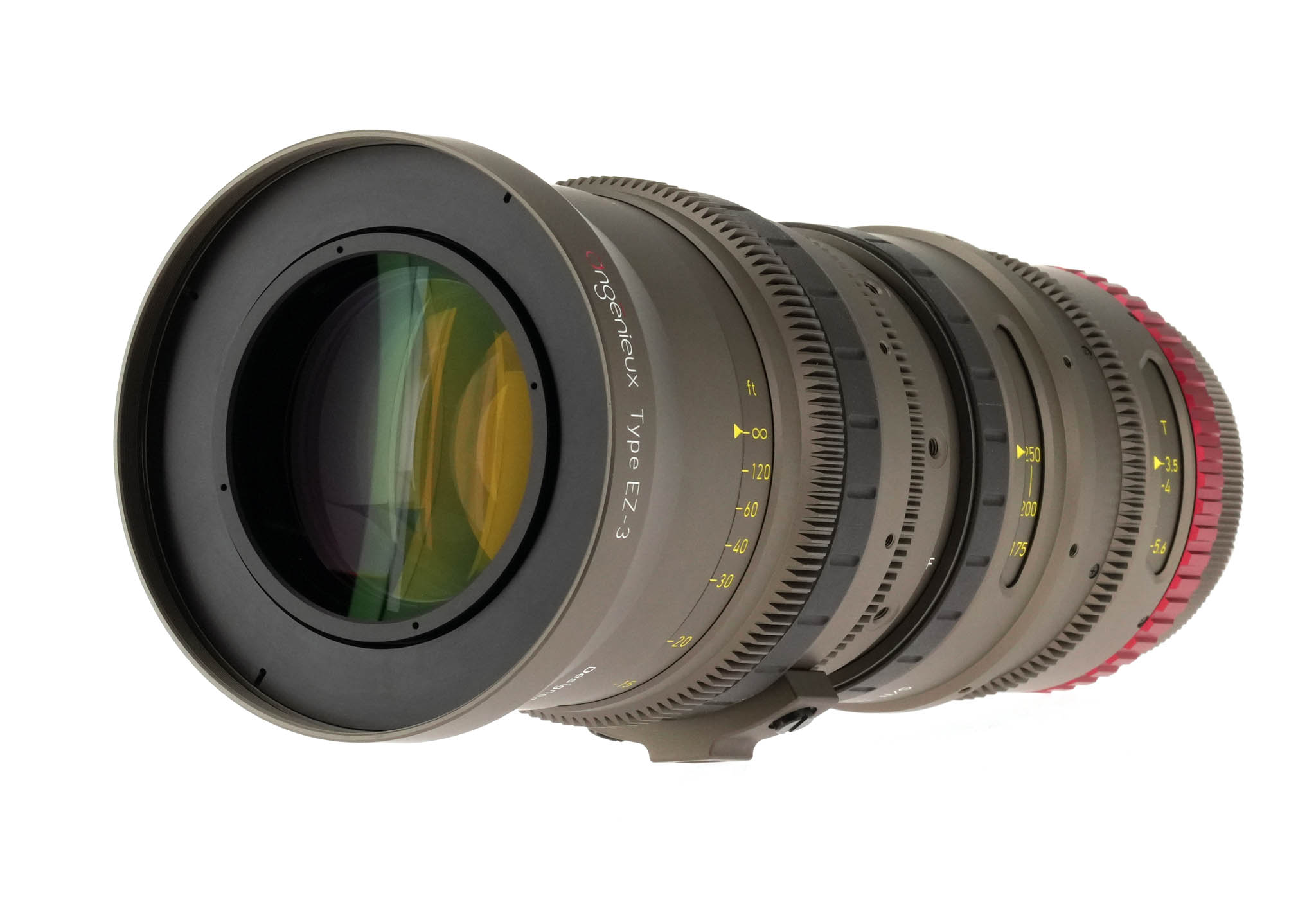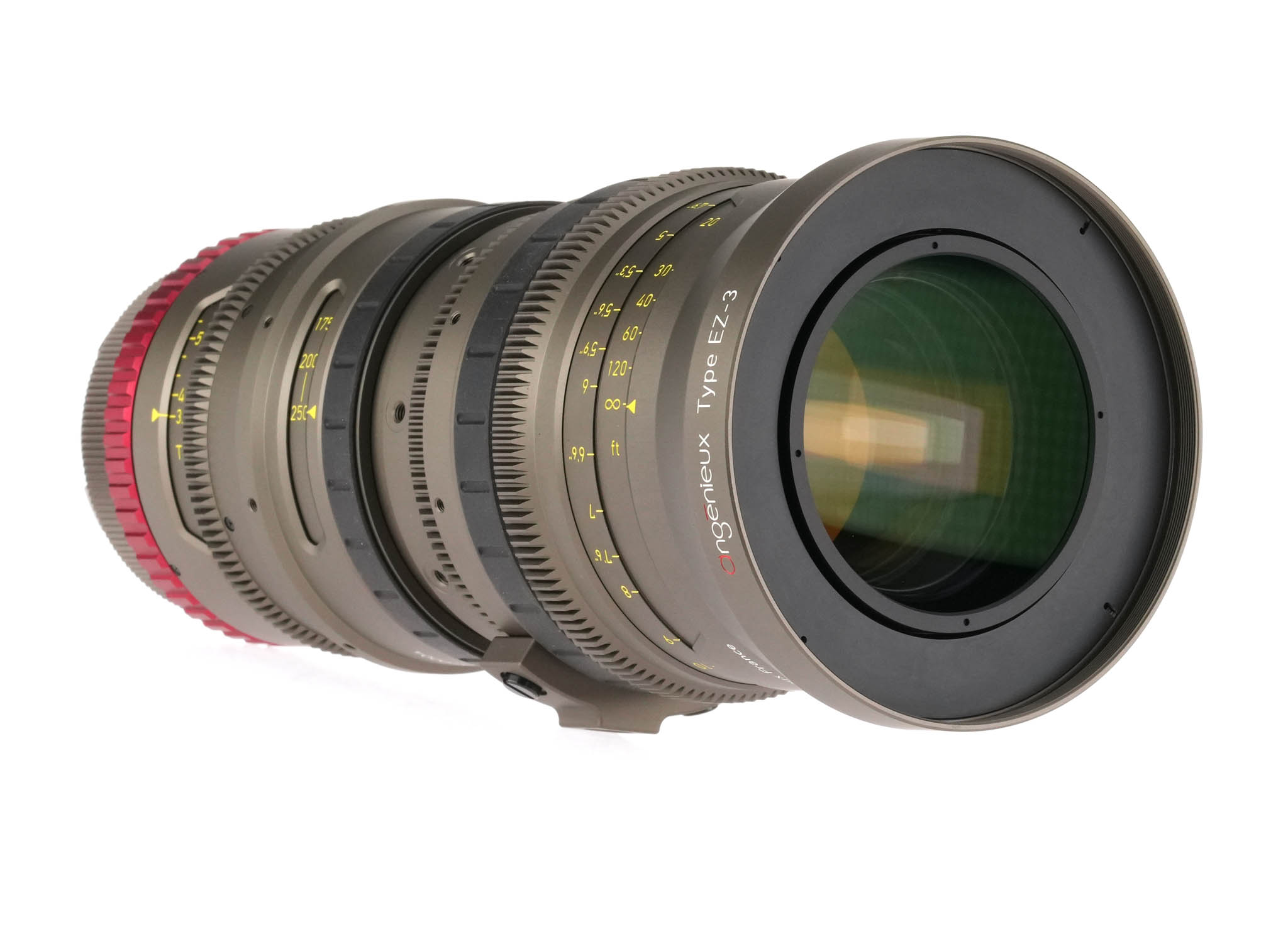Guillaume Dubois is a Product Manager of Cine Lenses at Angénieux. He started at the company in 2009 and worked in the production line as a process engineer, working on big lenses like the Optimo 24- 290, Optimo 17-80 and Optimo Ultra 12x. He joined the design and industrialization team for the EZ-3. Guillaume graduated from the National School of Micro Mechanics: Supmicrotech ENSMM
Jon: It took me 5 minutes to swap the EZ-3 from Full Frame to Super35. Do I pass your test? I was worried because somebody told me it should be three minutes.
Guillaume: Five minutes is very good and realistic. I can do it in three minutes, but I have a lot of practice.
How did you come up with the EZ-3 concept?
We always start from our customers’ needs. Therefore, it was natural to propose a tele lens after the “standard” EZ-1 and the wide angle EZ-2, to build a comprehensive lens series that would expand their possibilities.
Please tell us about the design.
The EZ-3 design started in 2021. In fact, it was pretty quick, con sidering that there was the design phase, the industrialization and the production ramp up.
How did you decide on the focal lengths?
Focal lengths of a zoom lens are always a matter of compromise. The idea was to optimize the lens for longest and widest practi cal focal lengths possible while also keeping the fundamentals of the EZ family: light weight and compatible with both Full Frame and Super35, with the same front diameter. We wanted to keep the same front diameter. EZ-3 had to be exquisitely complementary to EZ-1 and EZ-2 in terms of focal lengths.
But there’s a bit of an overlap between the EZ-1 (45-135mm Full Frame) and the new EZ-3 (68-250)?
Ultimately, such a series is always a question of compromises. The idea was also that you could carry just two Type EZ Zooms if you wanted to travel light. You could take the EZ-2 (22-60 in FF) and the EZ-3 (68-250 in FF). You go from 22 to 60mm and then you jump 68 to 250mm, you’re only missing eight focal lengths.
What were some of the other important things that you and the team wanted this new lens to have besides the focal lengths?
The new EZ-3 has the largest zoom range, at 3.7x. The range of the EZ-1 is 3x, and EZ-2 is 2.7x. We tried to optimize the range, know ing it is a tele lens. We had a lot of internal discussions, and we ended up saying that having a bigger range for the tele objective is a good idea, but keeping the lens at the same 114mm diameter as the EZ-1 and EZ-2 involved a choice we had to make. That choice allowed us to have controlled ramping on the tele side of the lens. There is a little bit of exposure ramping beyond 200 mm in Full Frame, but this is the price to pay to get that extra range. We spoke with our end users and they agreed it was a good option to go further knowing that they would have a little bit of ramping.
If you close down the aperture beyond a T4.5 in FF (3.5 is S35) there’s no more ramping?
Correct. If you stop down past T4.5, you can do a full zoom of the entire range without any ramping. There’s a line on the zoom scale that shows where ramping might occur.
Who are the intended users of the EZ-3?
For EZ-3 as well as EZ-1 and EZ-2, the intended market and users are independent filmmakers, but they are also very popular for applications such as Steadicam, news and documentaries. The EZ series, including the EZ-3, is for anyone who wants lightweight, cinestyle lenses with the best value for the money.
If you’re a high-end DP renting from a high-end rental house and they have both the EZ-3 and the Optimo Compact zooms, what are the main differences?
The EZ zooms do not have the same type of mechanics and optics as the Optimo lenses. They also have different characteristics. For example, they do not have lens metadata. Also, they do not have the traditional Angénieux Optimo look.
In terms of overall performance, the EZ family is optimized to match with cameras from the same category, the so-called entry or mid level. Optimo lenses are made to match high-end cameras and production needs. So they have different specifications. In other words, we accept some compromises on EZ lenses that we would not make on Optimo lenses, but this is extremely well managed to offer them at the right price and quality level. EZ lenses are optimized for different optical frequencies. Also, they do not have the traditional Angénieux Optimo look. Having said that, their cinematic look is very much appreciated as well.
Please define the two different looks—Optimo and EZ.
The ingredients are a secret sauce :) The EZ lenses have a good cinematic look, but not the traditional Angénieux look.
Do Optimos have smoother skin tones? And EZ zooms have less resolution and more geometric distortion?
Yes. Frequencies, distortion and resolution for sure. We are one step below the Optimo, otherwise they would cost the same price.
But even high-end DPs have been happy to use EZ-1 and E-2.
Yes because EZ lenses are good lenses and they have proved it. However, when they use them, it’s usually because of the aperture or the fact that they were one of the only, very fast aperture Full Frame lenses on the market. They used EZs a lot before the Angénieux Optimo Ultra Compact zooms arrived. Or they use them for different applications—on stunts, car chases, scenes like that, and on Steadicam, gimbals, and handheld.
Good point. Dan Ming, camera assistant and God of Focus who did News of the World, was using EZ-1 and EZ-2 and he said they didn’t seem as mechanically strong as the Optimos.
EZ lenses are robust lenses, but their mechanical construction is lighter. They do not have the Optimos’ historical, rugged me chanical construction with stainless steel rods. EZs have a design that is lighter and smaller. When you buy an Optimo, you know that this lens will last for more than 10 or 20 years. EZ lenses are not made to last for so long, which is a reason why they cost much less. Having said that, EZs are still very good and we have a very limited amount of returns on them, even after more than five years of demanding use. If you buy your own EZ lens and if you take care of it, you can keep it for years and years as an owner operator or a rental company with in-house lens technicians.
What mounts are you offering? PL, E-mount, what else?
We have PL, E-mount, EF and RF.
Are you considering LPL?
No. There are many LPL to PL adapters available as accessories.
Can you please expand (not extend:) on the optical design?
We tried to optimize the number of optical lens elements and making compromise so this lens could be more affordable com pared to an Optimo. But what is also very important is that on the EZ-3, the Full Frame and Super35 designs were also done in parallel, at the same time. It was not a Full Frame first, and then a speed-boosted Super35 lens. Furthermore, it was not Super35 lens with an expander. Every version was optimized as a complete lens set designed at the same time.
Many people still think that the EZs are essentially Super35 zooms with expanders.
No. That is not the case. None of our lenses that have IRO (Inter changeable Rear Optics ) technology are lenses with an expander. They are fully designed from the beginning to integrate that IRO rear module for flexible format coverage with accompanying focal lengths and apertures.
That includes the Optimo Ultra 12X?
Absolutely. It’s not a speed booster technology or an expander technology. They are two lens designs growing in parallel and every time we try to improve. That is the point of IRO technology to have two, fully complete zoom lenses. Basically the IRO technology is a full part of the original optical design and the optical calculations as a set. The IRO concept is a strength of Angénieux because it shows that our lenses are totally flexible and can change the image format size.
To reiterate: in terms of optical quality, I think it’s important for people to understand that the EZ lens versus the Optimo is a good lens. It’s just that the EZ lens is optimized for certain types of cameras, productions and budgets. It would be a nonsense to make an EZ lens that would be over-specified.
The EZ-3 also has a very easy way to switch from Imperial to Metric focus scales.
We have double scales—for feet and meters. You can simply re- move the ring, flip it and you can switch from meters to feet in the same time as for the IRO’s aperture and zoom scales. It takes less than five minutes. It’s quite practical and that is just one of the new ideas that are on the EZ-3.
Can you swap the focus scale in three minutes?
I think so, yes. It’s not a question of speed. Because of the IRO technology, you might swap from S35 to Full Frame every day if you want, but going from meters to feet probably will only hap- pen when you’re prepping the job with the lens.
Read the full interview at the link below…









